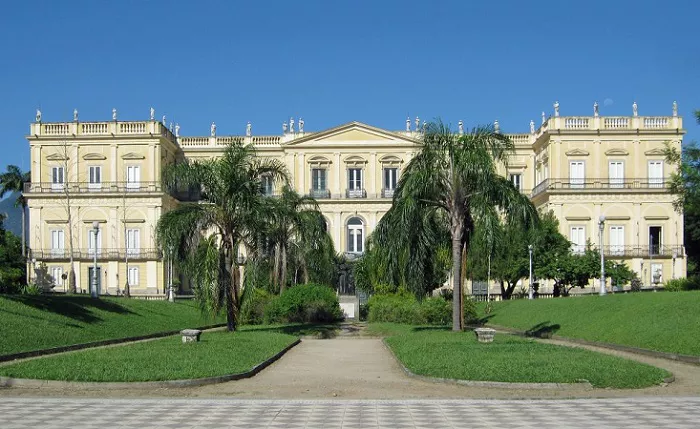Nearly seven years after a catastrophic fire destroyed the majority of its collection, Brazil’s National Museum (Museu Nacional-UFRJ) in Rio de Janeiro will partially reopen select galleries to the public this month. The initiative offers a rare glimpse into the museum’s extensive reconstruction efforts and previews elements of its full reopening, which is scheduled for 2028.
Starting 5 June, the museum will conduct guided tours through three restored rooms of the historic São Cristóvão Palace. The first room, located near the entrance, features decorative wall paintings from the 19th century that were uncovered during restoration. At its center stands the Bendegó meteorite—an iconic piece discovered in 1784 in Bahia and one of the few artifacts to survive the 2018 fire.
Suspended in the courtyard stairwell is a 15-meter-long skeleton of a sperm whale, discovered in 2014 in Ceará and donated to the museum in 2022. The area now features a skylight, replacing the previously open-air space. Another gallery showcases newly donated items, including fossils, manuscripts, ceramics, and Indigenous artifacts. These spaces also highlight the museum’s ongoing reconstruction efforts and the global support it has received.
The fire on 2 September 2018 engulfed the museum, which then housed approximately 20 million objects, eradicating nearly 90% of its holdings. The building, once the royal residence of the Portuguese crown, became the National Museum in 1892 but had suffered from years of neglect and chronic underfunding prior to the disaster.
Reconstruction of the museum is currently budgeted at 516.8 million reais (around $90.4 million), although an additional 170 million reais ($29.8 million) is still required for completing building renovations and preparing long-term exhibitions, according to a museum spokesperson.
Since the fire, the museum has received over 14,000 donations from institutions and private collectors worldwide. Among the most significant is the return of a rare 16th-century Tupinambá feather cloak, repatriated from the National Museum of Denmark. A dedicated memorial is planned at the site where the blaze began, commemorating the artifacts lost.
Restoration teams continue to work on salvaged objects, including fragments of “Luzia,” the oldest human fossil ever discovered in Latin America. Initially presumed lost, parts of the skull were later found in the rubble.
Affiliated with the Federal University of Rio de Janeiro (UFRJ)—the oldest scientific institution in the country—the museum remains a cornerstone of Brazilian academic life. Its director, Alexander Kellner, appointed six months before the fire, has led a range of fundraising efforts. These include securing 5 million reais ($980,000) in federal funding to restore archaeological, geological, paleontological, and biological collections.
“It is not only the first museum founded in Brazil but also the country’s first scientific institution,” Kellner stated. “One of the most crucial aspects for maintaining these teaching and research initiatives is the preservation of the collections.”

